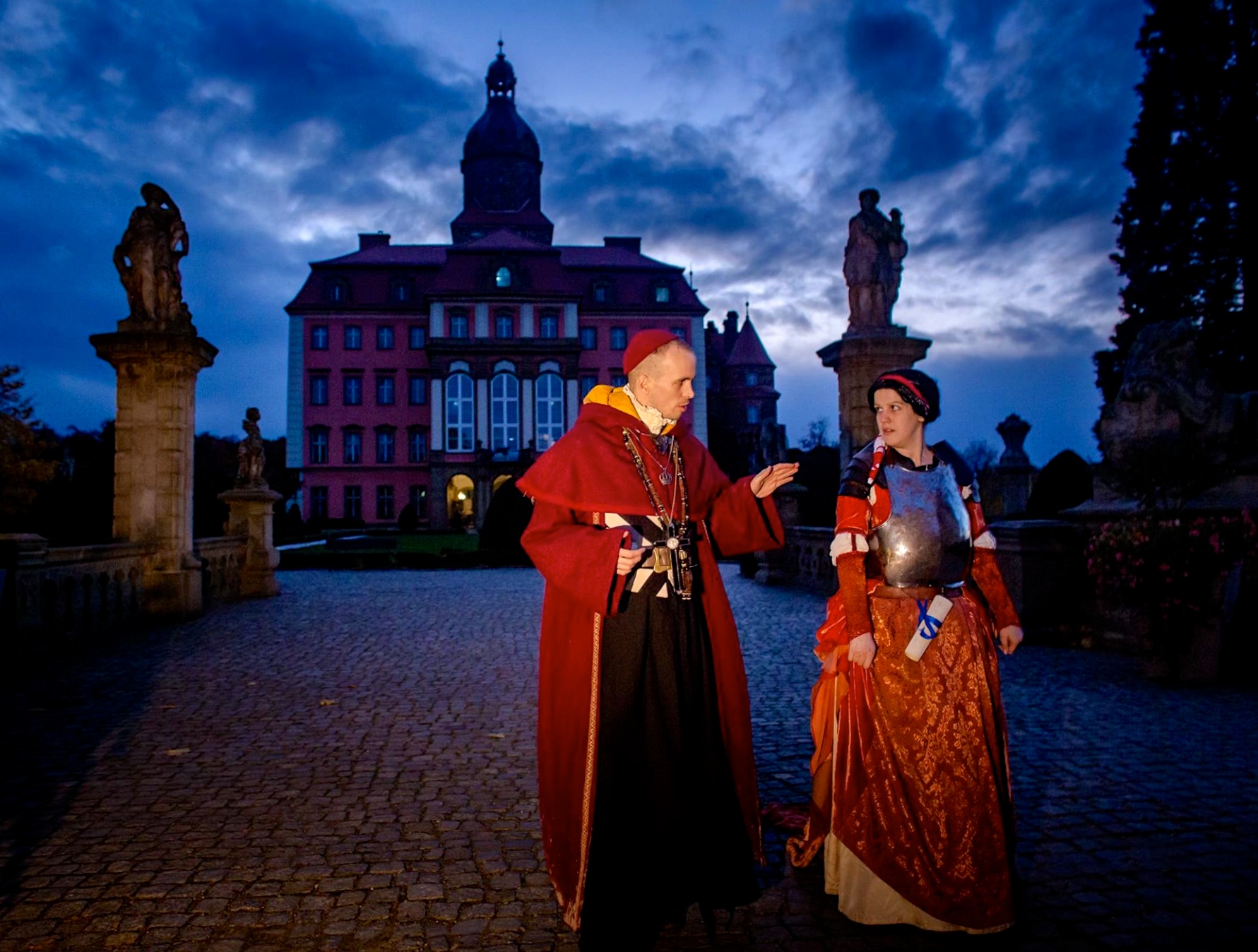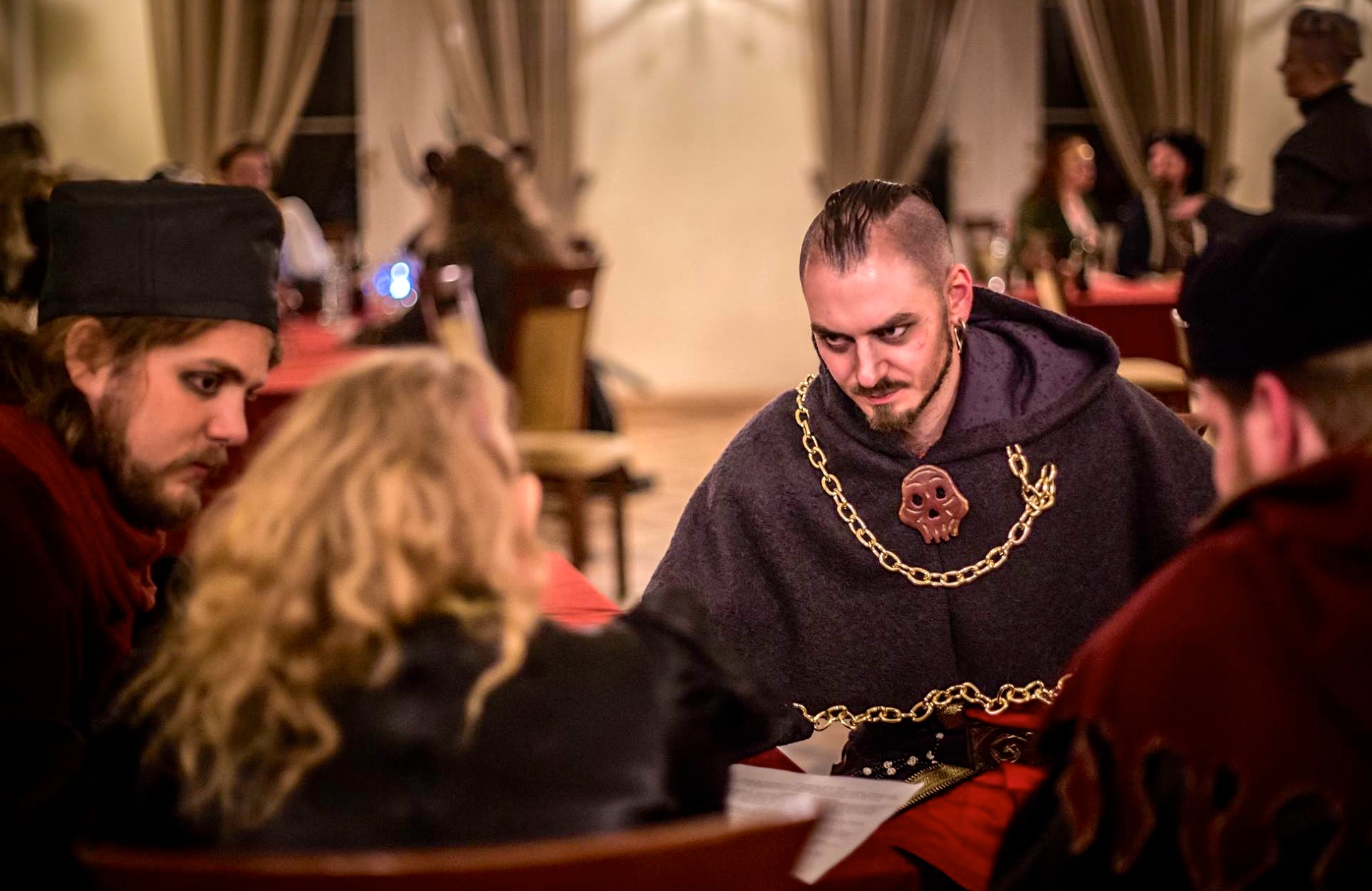
Quickly making a name for themselves with “Blockbuster larps” known for their immersive style thanks to the elaborate costuming, lavish locations befitting the rich setting, and character backgrounds first done with their highly successful College of Wizardry series, Dziobak Larp Studios delivered again as they transformed a Halloween weekend’s stay at a Polish castle into a gathering of the Damned. Canonically this gathering represented perhaps the last chance for the establishment – what would become the Camarilla – to pitch their “Traditions” (code of conduct) in a bid to bring an end to the war whose continued escalations only brought them closer to their vampiric existence being exposed to the Catholic church, while the more Libertine inspired Anarch movement preached self-determination to the establishment rank-and-file childer, a Gehenna cult established warbands – what would become the Sabbat – to prepare for the clan founders return who it was believed would feast upon their respective bloodline to sate their ancient thirst from millennium of slumber, and a handful of independent clans who decided to go it alone. But as can be expected with any group of players, the outcome of our Convention differed in some regards from the canon material – like the Giovanni deciding to join the Camarilla and get their own Justicar; who would have thought that would have happened given their canonically self-avowed independence.
Giovanni Justicar confers with his minions
Run as a joint collaboration between White Wolf and Dziobak, the Convention of Thorns was held over the Halloween weekend of October 27-30, 2016 at the Zamek Ksiaz castle in Poland, giving players the opportunity to play out one of the most crucial moments in Vampire: the Masquerade canon during which representatives from the gathered vampire clans met at an English monastery [circa 1493] for peace talks between the network of Elder led cities and domains usurped by their Anarch childer or otherwise sympathetic to these revolutionaries, all against the backdrop of an Inquisition that was spreading across Europe in a tide of fire. Following decades of brutal civil war that pitted “family” against one another, the Convention is seen by many as perhaps the last chance to find some degree of peace before the Catholic church becomes truly cognizant of their existence, and leads a crusade to purge vampires from the face of the Earth once and for all.
Players adopt the roles of the attendees, and partake in the proceedings as their background and personal interest might dictate. Ostensibly this gathering is an opportunity for the various factions to determine what manner of government they might allow rule over them to ensure a more peaceful coexistence, but given the distances some of these kindred would travel, many had much more personal reasons for attending. Even though many of the notable canon attendees were represented at the larp by members of the cast given the opportunity to portray such characters – all of whom seemed to find their own way embodying these well-known and somewhat iconic personalities from the literature – there were a great number of us who were playing characters that had been written up specifically for the Convention with input from us. In our case, Nicole ended up cast as Melinda Galbraith, a canonically notorious Elder killer who became a Sabbat leader, while I had the opportunity to pitch my concept for a blood merchant who was in attendance attempting to expand his clientele. Both of us had a cluster of characters immediately connected to ours that we were able to with varying degrees establish some background with via Facebook, but found the day play offered at the larp to help flesh these relations out, or in some cases explore a character’s past, to be much more effective facilitating the formulation of such ties. That’s not to say the work put in beforehand was a waste of time, but I would treat it more like a sketch of what you’re planning on doing at the game, leaving you flexibility for when you discover what your weekend’s story is going to be as you immerse yourself into the character and finally meet some of the other players in person.
Melinda Galbraith & Christopher Lancaster
However despite this game being steeped in White Wolf canon, players were encouraged to rely solely on the Design Document provided before hand for the basic game setting as not all participants were necessarily familiar with the literature, or have a varying degree of exposure given the extensive World of Darkness catalogue. This ensured that players assigned canon characters need not be familiar with much more than what was provided in their background, and whatever decision they made going into the game about what that those motivations might be. Players were also encouraged to contact their respective background writer, and express any interests they might have incorporated into their character. Personally this worked rather well for what I ended up with, and was pretty much what I had been envisioning when I decided on what I wanted to be doing at the larp.
With participants coming from across Europe and a growing contingent of North Americans, the Convention of Thorns like many Nordic larps was held in English, utilizing a handful of verbal mechanics that were workshopped on the first day to help facilitate game play, in conjunction with a series of phases that incremented over the course of the weekend which indicated the potency of your character’s powers that could be used at any given point – especially important to Elder characters who had a range of effects available to them; rather than the trait expenditures and rock-paper-scissors challenges that typifies the Mind’s Eye Theatre rules which dominates most White Wolf larps. The combat system in fact was the most refreshing change from the aforementioned World of Darkness larps that inevitably ended up in a “time stop” with players battling it out with their stats. Instead characters could “duel” one another by issuing a number of insults equal to their dueling stat until a clear “victor” emerged. Which meant players were encouraged to remain within the scene and engage in banter – or if choreographed beforehand through their fight – ensuring minimal disruption to the game play around them (i.e. no time stops) and some brilliant exchanges that often provided an entertaining diversion if there happened to be a lull in conversation you were having when the duel broke out. There of course was the caveat that individuals could arrange to have a group swarm them – which I can personally attest witnessing when a pack of Tzimsice carried off one of the Tremere Lords – but more of that when I write a review from Christopher’s vantage. The rule of thumb however was that you got to decide the fate of your character.
This type of consent-based play even extended to the physicality between players, noted by one of the lead organizers being due to the simple fact that such a large group coming from in some cases very different play-styles, as it was the best way to ensure everyone had fun, and so players were encouraged to inquire whether the person they were interacting with consented to intimate touching or “feeding” – and in some cases “violence” – leaving the recipient to determine how that might occur (which was taken from a larp called End of the Line that developed and piloted these techniques). However in practice it appeared that many arranged things in advance, or were largely prepared to roll with events as they occurred. And if you didn’t like what was happening, you could simply put a hand across your eyes as you peered down at the ground indicating you were leaving, which no one could stop you from doing or query you on. Everyone simply went about their interactions in the scene.
Perhaps the most interesting departure from the typical White Wolf larps – where characters actively hoard information while plotting in the shadows to destroy their enemies and get one up on their rivals – all of the backgrounds were made available publicly; which for some meant they could legitimately establish themselves as an information broker, but not necessitate that the element of surprise be completely foregone. As the game ramped up, players took this material, which inevitably underwent a permutation due to their involvement and their respective interests have on pre-generated material, and ran with it. Like plans when they meet the enemy, content regardless the intent behind how it was written, is co-opted by the players who focus on those aspects that interest them, and downplay anything that doesn’t resonate.
Game play was structured around clan meetings, council deliberations, and votes held at varying points of the weekend. However even these were subject to consent, as expressed the second night by one of the lead organizers who reminded everyone of the hand over eyes mechanic for extracting oneself from a scene, could especially be used if you’re finding it boring or otherwise stifling to your entertainment – again more of this when I write about playing a Tremere.
In addition to the stunning location offered by the Zamek Ksiaz castle, which came complete with a gold-gilded great hall that Dziobak Larp Studios was able to secure for the opening scene, not to mention a portrait photo, the scenography team transformed several rooms into areas of play for the clan and council meetings – complete with themed music and decor – that sought to set the mood for those interactions, along with the top floor which had been damaged in a fire and was being provided for darker and often messier scenes as there were certainly players interested in exploring the more monstrous aspects of vampires, while the main floor was reserved for more “civil” play and where the were votes held – which required participants to line up behind their choice – and will be interesting to compare notes with future runs to see if they suffer from the same chaos that seemed to plague ours when it came time to actually casting our votes. However I do feel like the final vote that resulted in the room dividing for or against the fledgling Camarilla should have be done clan by clan like the others votes of the weekend. It would have had much greater emotional impact if characters had been able to witness the decisions made by those who were “family” or allies. An opportunity for lines to be drawn.
Zamek Ksiaz castle grounds
Zamek Ksiaz great hall
Clan & council rooms
Fifth floor
Main floor
All in all it was an exceptional larp to attend not only for the aforementioned reasons, but also because of the caliber of roleplay and costuming that all of the players brought with them to the weekend.
Some attendees have already committed to returning to one of the 2017 runs. I know I’d be tempted to play again as a different character. If you’re interested, here’s another blog post about the weekend by Sarah Lynne Bowman, one of the contributors to the design document and who more importantly helped ensure the game was a safe place for everyone as a member of the Safety team. However if there is one criticism I have for the weekend, it’s not getting to tour the floors of the building beforehand. Because of the lighting – and it sounds like I wasn’t the only one who missed the door – there was an entire floor that I never got the opportunity to see, having not been able to find the entrance. To be honest the building was pretty expansive, and contained a number of wings not being utilized during night play, which I can personally attest to having gotten lost in for about half an hour the second night. A shame as Sarah was playing one of the more humane characters in attendance, and had taken that floor over for her private salon where the Harpies – MCs from various domains – were to meet, which meant we never got to interact after setting some things up on Facebook. But that’s otherwise a pretty minor complaint, as I found myself extremely busy despite having done very little to establish connections.
Thanks to the photography team for all their efforts capturing these memories – especially John-Paul Bichard, Przemys’aw Jendroska, & Nadina Wiorkiewicz.


![How to play a Wizard CoW-style [Repost]](http://www.cultureaddicthistorynerd.com/wordpress/wp-content/uploads/2014/12/wizardrycollege-crest-150x150.jpg)
![Nordic Larp Talks: Wizardry 101 [Repost]](http://www.cultureaddicthistorynerd.com/wordpress/wp-content/uploads/2015/04/czocha-castle-150x150.jpg)





































I am very impressed at the production values of this event. Not being in the LARP scene myself some of the terminology is a bit opaque, but I suspect that reading some of your other posts will clear that up. In any case it’s obvious that much care went into making this a rewarding event and I can only see this pastime growing if this is the direction it is involving towards.
Yeah, this company in particular known for this level of production value, and has become a model that other countries are quickly trying to export. However these guys aren’t shy about traveling to do different events. In fact the lead organizer I mentioned in this article traveled down to Disney World earlier this month to talk with them about such a possibility at the parks. And apologies about the terminology, attempted to write it for the uninitiated. Definitely let me know if there’s something I need to put up a post about to help explain this stuff better.